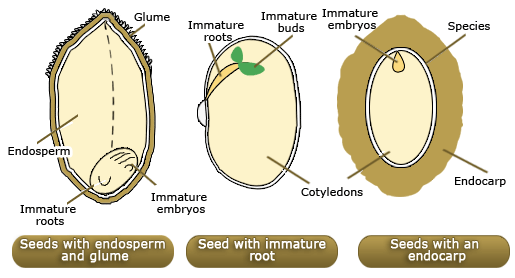- 글로벌메뉴
- KOREAN

 Korea Biodiversity Information System > Plant Resource > Seed Information > Seed Classed
Korea Biodiversity Information System > Plant Resource > Seed Information > Seed Classed
A seed is also called a pit. A seed corresponds to the dormant phase in a plant's life cycle, and the embryo contained within it eventually sprouts into a young plant and creates a new generation. A mature seed is composed of an embryo, endosperm, and seed coat. Seeds are mainly divided into albuminous seeds with endosperms and exalbuminous seeds without endosperms. The seed coat surrounds and protects the embryo. Endosperm is created in the central nucleus of the embryo sac and stores nutrients, but an exalbuminous seed contains nutrients in its cotyledon. Seeds can be divided by storage substance: starch seeds such as rice and corn, and fat seeds such as canola, castor, and sesame. Seeds are usually resistant to drying when they enter a dormant phase with maturity, and are germinated when the oxygen, temperature and moisture conditions are adequate. Plants can produce seeds once or several times during their lifetime depending on the seed production type.

Herbaceous plants belong to higher plants with xerophytes, and most of them proliferate mainly through seeds. Thus the conservation of seeds has great importance for genetic resource conservation. Because a seed contains the comprehensive genetic traits of a plant, it has many advantages that can be utilized for the preservation of endangered species and breeding of resources. Although seed preservation is the most important and essential part of botanical research, the vast amount of time and costs required for seed collection forces many researchers to avoid this field. At the moment, each nation strictly prevents the outflow of its endemic plants while strenuously collecting foreign seeds to secure and preserve biological diversity and genetic resources. Korea has been progressively losing genetic diversity through uncontrolled land development, and fundamental countermeasures are required as soon as possible. In this sense, this seed database is expected to play a crucial role in seed conservation and plant diversity research in Korea. The importance of a seed database centered on seed collection and conservation is increasing. Korea, a genetic-resource-poor country, should not only focus on preventing the outflow of endemic species but also make efforts for the further liberal transfer of information between scholastic groups. It is crucial to establish an efficient seed database for current and future genetic resources.
Every plant has a different blossoming and seed maturing period, but herbaceous plants take one to two months after blossoming for maturation. On the other hand, plants such as rice require a longer maturation period of about three to four months. For xerophyte seeds, 80% of them mature in September and October, and the rest mature from June to August.